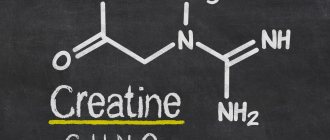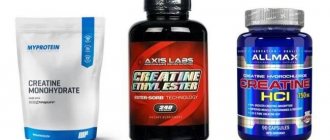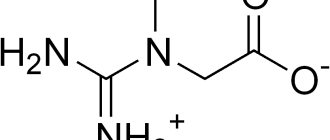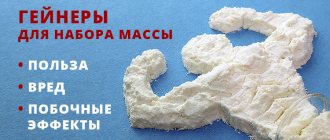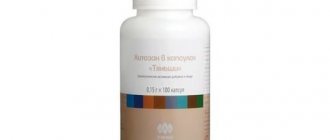The article will discuss what creatine monohydrate is, who should take it and how, what beneficial properties this substance has, and much more.
Creatine monohydrate is one of the most popular supplements among people looking to build muscle, improve performance, and increase strength.
Despite the fact that this substance is quite well studied, there is still a huge amount of misinformation about it. This guide contains only the facts about creatine monohydrate and is designed to answer all your questions.
If you have any comments or if anything is unclear, please leave comments below.
How does creatine work?
Creatine is the main source of ATP (the body's main energy substrate) in the short term during high intensity exercise. In the human body, creatine is present both in free form and in the form of creatine phosphate.
Creatine phosphate replenishes ATP stores in muscles when they contract rapidly. If muscle tissue runs out of creatine, it is unable to generate effort.
The use of creatine as an ergogenic aid is based on the theory that creatine reserves can be increased through supplementation. This is a very important point, which we will discuss below.
Which manufacturer to choose
Unlike other forms of creatine, when choosing monohydrate, it is important to choose the right brand. Why?
- Manufacturer's pricing policy. With the same characteristics of sports nutrition, the price can be completely different just because of the brand.
- Expiration date and delivery. If you purchase BSN creatine, this is not a problem, but if you want to take creatine from Ostrovit, remember that the shelf life of their raw materials is much shorter. For this reason, you should not take creatine in large packaging.
- Availability of a transport system. To reduce the cost of the product, the manufacturer often adds a transport system (glucose molecules) to it. This creatine has greater bioavailability, but less effectiveness due to the concentration of crystals relative to the total mass of the product.
- Crystal purity. Recently, more and more manufacturers have appeared on the market who cannot provide sufficient crystal purification. The bioavailability of their product is significantly lower, which increases consumption and reduces the effectiveness of taking the monohydrate.
- Solubility. This parameter can only be verified experimentally. Despite the statements of all manufacturers that their creatine is ideally soluble in water, practice shows that part of the creatine remains in the form of sediment.
Let's look at the best manufacturers who offer creatine on the market - and complexes containing it.
| The product's name | Manufacturer | Product weight | Price | Editorial rating |
| NO-XPLODE Creatine | BSN | 1025 g | 18 USD | Good |
| NaNO Vapor | MuscleTech | 958 g | 42 USD | Good |
| Micronized Creatine | Dymatize | 500 g | 10 USD | Poorly soluble |
| Micronized Creatine Powder | Optimum Nutrition | 600 g | 15 USD | Good |
| HEMO-RAGE Black | Nutrex | 292 g | 40 USD | Excessively expensive |
| Fierce | SAN | 850 g | 35 USD | Average |
| Creatine Monohydrate | Ultimate Nutrition | 1000 g | 16 USD | Good |
| Cellmass | BSN | 800 g | 26 USD | Average |
Beneficial features
Creatine is one of the most widely researched supplements. More than 7,000 scientific articles are devoted to this topic. Hundreds of studies have proven the beneficial properties of creatine monohydrate, including:
- Increasing muscle creatine levels
- Increased performance and improved training performance
- Muscle growth
Below are detailed explanations of these properties.
Increased muscle cretin levels
In order to experience the benefits of creatine, you must replenish creatine stores in your skeletal muscles. According to recent studies, supplementation increases muscle creatine levels by 10-40%.
These results were observed after the so-called creatine loading. It involves taking the substance at a rate of approximately 0.3 g per 1 kg of body weight per day for 5-7 days and 3-5 g per day after the end of this period.
However, the practice of creatine cycling has not been shown to be very effective in maintaining elevated levels of this substance in the body.
Increased strength and performance
Creatine is currently considered the most effective legal supplement for improving anaerobic endurance and increasing lean body mass. About 70% of studies showed a significant increase in exercise capacity in people taking this substance.
In both the short and long term, creatine improves overall training performance, resulting in 5-15% increases in strength and performance. According to the results of almost all studies, proper consumption of supplements increases body weight by about 1-2 kg in the first week of creatine loading.
As the authoritative journal International Society of Sports Nutrition states, “The vast body of positive research on creatine suggests that it is the most effective supplement for building muscle mass and improving performance in high-intensity exercise.”
Creatine and its types
Because creatine comes in several types, it can be difficult to choose the right type that will help you make your workouts more effective. Let's look at the most common types of creatine you may encounter when purchasing supplements.
Creatine monohydrate
Creatine monohydrate is the most common type of creatine on the market. It is also the form that has been most scientifically researched and tested by experts in many studies. Essentially, this means that most of the scientific benefits of creatine are observed when consumed as the monohydrate.
Creatine monohydrate consists of a creatine molecule and a water molecule . However, various preparation methods are used in its production. If a water molecule is removed, it is creatine anhydrous . Removing water increases the amount of creatine in the product dose. Creatine anhydrous contains 100% creatine , while classic creatine monohydrate contains approximately 90% pure creatine. At the same time, the amount of creatine in the product affects the final cost of the dietary supplement.
Other types include micronized creatine or mechanically processed creatine, which has better water solubility . Theoretically, it is possible that better solubility of the product leads to faster absorption of the substance in the body , but this fact has not been sufficiently confirmed. [9]
Despite these slight differences in processing, each form of creatine monohydrate is likely to be equally effective at the same dose. Even 5-10g of creatine monohydrate can lead to increased performance, muscle endurance and muscle size. [10]
Creatine hydrochloride
Creatine hydrochloride (HCl) is convenient due to its good solubility in water . This form is the result of creatine binding to a hydrochloride molecule. One study confirmed that creatine hydrochloride is 38 times more soluble than creatine monohydrate. It is also believed that creatine HCl may be absorbed more efficiently into the body . This is why most supplements containing this type of creatine contain less than 1g of active ingredient per dose. This is a significantly smaller portion compared to creatine monohydrate, which is typically consumed in 5 gram doses. [10]
Unfortunately, there is not enough research to confirm this effect in humans. also a lack of research examining the differences in the effects of creatine HCl and creatine monohydrate. However, this does not mean that creatine HCl is not effective. Conversely, it is suitable for people who have stomach problems from creatine monohydrate. These side effects are much less common when consuming creatine hydrochloride . [11] [12]
Kre-Alkalyn – buffered creatine monohydrate
Kre-Alkalyn or buffered creatine monohydrate is a form of creatine that contains a slightly alkaline powder, such as bicarbonate. Manufacturers claim that its addition creates an alkaline compound that can reduce the breakdown of creatine in the stomach and improve its absorption into muscles . Kre-Alkalyn is sold alone or as a pre-workout stimulant.
Currently, only one study evaluates the effectiveness of this form of creatine. This is a study conducted in 2012 that showed similar performance improvements between different testing groups. The first group received 5 g of creatine monohydrate for 28 days , another group consumed an equivalent dose of Kre-Alkalyn, and the third group received a low dose of 1.5 g of Kre-Alkalyn daily. Groups receiving 5 gram doses began testing after a 7-day saturation phase using 5 grams of creatine 4 times daily. [13]
As a result, all groups significantly improved their muscle mass , body fat percentage, and strength in their legs and arms. Even the group that received lower doses and did not go through the saturation phase achieved comparable values . However, it is important to note that the subjects who took creatine monohydrate had an increased muscle creatine content of 50.4% after 28 days, while the group receiving Kre-Alkalyn only had an increase of 27.3%. [13]
This means that you will see the same results if you consume Kre-Alkaline and creatine monohydrate. However, when using Kre-Alkalyne, a lower dose seems to be sufficient and you do not need a saturation phase. [14]
Creatine magnesium chelate
Creatine magnesium chelate is another form of creatine that is produced by binding magnesium to the creatine molecule. Its properties were examined in one study in which experts compared bench press strength and performance among athletes divided into 3 groups. The first group received creatine monohydrate, the second group received magnesium chelate with creatine, and the third group received placebo. Both groups that consumed creatine improved their scores more than placebo. It follows that creatine magnesium chelate is effective , and no less effective than creatine monohydrate. [15]
Another study conducted in 2003 found that creatine magnesium chelate could improve performance without the addition of water , which is usually made with creatine. This would be especially helpful for athletes trying to maintain a low weight . In the meantime, however, we must treat this with caution because this fact has only been confirmed by one study and more in-depth research is needed. [16]
Creatine ethyl ester
Creatine ethyl ester is enriched with an organic component – ethyl ester. Some manufacturers claim that it is better absorbed and has a longer half-life than regular creatine monohydrate because it dissolves more easily in fat. Unlike the other types of creatine discussed in this article, ethyl ester is not a favorite . In different studies, the results of its effectiveness do not agree.
One study found that 7 weeks of consuming creatine ethyl ester resulted in a lower muscle-to-blood ratio of creatine than creatine monohydrate. In addition, its use may result in increased plasma creatinine Generally, creatinine is eliminated from the body as waste, but is not good for the kidneys, so the use of creatine ethyl ester is not recommended . [18]
Creatine citrate
It is produced by combining creatine with organic citric acid , which is found in citrus fruits and is often used as a natural flavoring in dietary supplements. However, a 2007 study by the International Society of Sports Nutrition found no significant difference in the absorption of creatine citrate compared to creatine monohydrate. However, creatine citrate is more soluble in water, but this is not a reason to believe that it is also more efficiently absorbed in the human body. [19]
Creatine malate
Creatine malate is bound to malic acid , another organic acid commonly found in fruits. Malic acid alone can improve endurance performance , which is why manufacturers have begun combining it with creatine. [10]
Creatine malate has been tested in several studies indicating that it improves anaerobic production in runners and judokas. However, no study has been conducted comparing creatine maleine monohydrate and placebo. Like creatine citrate, creatine malate is more easily soluble in water. [20]
Creatine nitrate
Creatine nitrate is one of the newer forms of creatine . Manufacturers claim that by binding a creatine molecule to a nitrate molecule, athletes will need a lower dose than creatine monohydrate. But let's look at the research results.
Research conducted in 2021 showed the effect of creatine nitrate on improving performance . However, the results did not confirm any significant differences between the groups of subjects receiving creatine nitrate, creatine monohydrate, or low-dose creatine nitrate. However, all of these groups achieved much better results than the placebo group. [17]
Creatine gluconate
This is creatine, which is bound by a glucose molecule . There is a theory that creatine gluconate is absorbed more efficiently because it is combined with carbohydrates enriched with insulin. However, no studies have yet been published to test this theory. [24]
Creatine pyruvate
Creatine pyruvate is produced by binding pyruvic acid and is a very interesting combination between the individual forms of creatine. However, research on its effectiveness is rather mixed. One study found that it had a better effect on endurance than creatine citrate (which is an effective form of creatine), but another study found that it did not improve endurance at all . [21] [22]
Some studies have also confirmed that, compared to creatine monohydrate, creatine pyruvate results in higher blood creatine levels . This may mean less creatine in the muscles, which is ultimately not effective. Therefore, this study concluded that creatine pyruvate is unlikely to be more bioavailable than creatine monohydrate. [23]
Creatine Alfacetoglutarate
It is also known as creatine AKG , which is made from alpha-ketoglutaric acid and creatine. Theories state that alpha-ketoglutarate, as a precursor to glutamine, is better absorbed in the intestine . It also serves to prevent stomach problems and diarrhea that plague some athletes when they consume creatine. In addition, users of AKG creatine claim that it is absorbed more efficiently and results in higher creatine concentrations in the muscles than monohydrate. However, there is currently not enough evidence from relevant research to support these theories. [10]
Multi-component creatine
Multi-component creatine combines several types of creatine in one product. It combines the benefits and properties of different types of creatine into one blend. For example, it can contain 7 types of creatine per product, such as our Crea7in. Physically active people and athletes will appreciate its benefits , such as faster absorption, muscle growth, more energy and better results. If you can't decide between different types of creatine, try multi-ingredient creatine.
How to take creatine correctly
As noted above, the purpose of taking creatine is to “saturate” the muscles with this substance. This effect can be achieved in a variety of ways, but loading seems to work best for quickly replenishing creatine stores as well as maintaining them. The dosage regimen should look like this: 0.3 g per 1 kg of body weight per day for 5-7 days and 3-5 g per day after this period.
What about the timing of taking creatine? Although it is often promoted as a pre-workout supplement, science does not support this view. Before delving into research, it’s enough to remember the very essence of creatine! It acts as an energy store, so one small dose before exercise will likely not sufficiently increase muscle mass to the extent needed to improve exercise performance.
Practice creatine loading and then maintain your creatine levels by consuming 3-5 grams per day. The timing of supplementation is not a significant factor.
In one study looking at the effect of timing of creatine supplementation on its effectiveness, 19 people were divided into 2 groups. The first took 5 grams of the substance before strength training, and the other after.
The first group showed improvements that were not observed in the second, but the differences were insignificant.
This suggests that the timing of supplementation is not a significant factor. You just need to practice creatine loading, and then go into a maintenance phase, consuming 3-5 grams per day.
Dehydration[edit | edit code]
Dehydration is directly related to the previous effect. The osmotic activity of creatine leads to the transfer of the liquid part of the blood into the muscles, thus, to some extent, the body is dehydrated, while metabolism, heat regulation, acid-base balance, etc. are disrupted. This dictates the need to consume a sufficient amount of fluid in a volume of up to 3 liters per day . Adequate rehydration allows you to normalize the electrolyte balance of the internal environment of the body, as well as prevent some other side effects of creatine.
This problem is especially relevant in bodybuilding, since many athletes, taking creatine, begin so-called drying with the help of diuretics and stimulants that remove fluid from the body, in which case significant harm can be caused to the body.
Side effects
For years, the media has portrayed creatine as a dangerous and “obscure” supplement that can have negative health effects when taken long-term. Unfortunately, they came to these conclusions due to a lack of information.
Some of the most common accusations against creatine include dehydration, injury, digestive upset, and even kidney and liver damage. However, to date there are no controlled studies to prove this.
The only clinically identified side effect of creatine is weight gain (due to increased water concentration within cells), which is typically the goal of those who take it.
We can say that man began to consume creatine since he began to eat meat, and this happened, according to scientists, more than 1 million years ago. The research of the substance itself began more than 40 years ago, when it began to be used experimentally to treat heart diseases and improve heart function after a heart attack.
At the same time, unconfirmed information probably appeared that creatine can lead to stomach upset when taken in excessively large doses (20+ grams). However, taking the supplement with enough water or switching to higher quality brands will usually eliminate this side effect.
Use of the drug
Bodybuilders use creatine to build muscle mass. The accumulated substance is used by the body to improve performance in those sports that involve the use of peak force in short periods of time. The use of the drug is recommended:
- when performing intense training exercises;
- when running short distances;
- in cycling sprint;
- in weightlifting;
- when jumping;
- hockey players, football players, tennis players;
- vegetarians
Forms of Creatine
First of all, it is worth noting that there are 2 forms of creatine: creatine monohydrate and creatine ethyl ester. Moreover, the first is much cheaper than the second. Creatine ethyl ester is often promoted as a more effective form due to increased bioavailability, however, these claims are not scientifically supported.
Both forms have been experimentally proven to increase creatine levels in muscles, but some studies suggest that creatine monohydrate may be more beneficial in this regard.
One way or another, creatine monohydrate and creatine ethyl ester are effective and very similar in their effects.
Composition and release form
The substance is an organic compound – carboxylic acid. Creatine Monohydrate contains amino acids linked by peptide bonds (arginine, glycine, methionine), which hold water molecules. The food supplement is produced in the form of tablets, capsules or white powder; plastic or metal cans are used for packaging.
The substance was first synthesized as Creatine Monohydrate, and now this form is the most popular. Other known creatine supplements:
- Crealkaline;
- Creatine hydrochloride;
- Creatine phosphate;
- Tricreatine malate.
The best brands of creatine producers
- MUSCLETECH
Cell-Tech
- Calorie content: 180 kcal
- Creatine content: 7 g
- Carbohydrate content: 38 g
- DYMATIZE
Creatine Monohydrate
- Creatine content: 5000 mg
- NUTREX
Creatine Drive
- Creatine content: 5000 mg
- ATHLETIC EDGE
Creatine RT
- Calorie content: 5 kcal
- Creatine content: 5450 mg
- Carbohydrate content: 1 g
- PROSUPPS
Creatine
- Creatine content: 5000 mg
Links[edit | edit code]
- Groeneveld, G. J., Beijer, C., Veldink, J. H., Kalmijn, S., Wokke, J. H. J., & van den Berg, L. H. (2004). Few adverse effects of long-term creatine supplementation in a placebo-controlled trial. International Journal of Sports Medicine, 25
- Mayhew DL, Mayhew JL, Ware JS (2002). "Effects of long-term creatine supplementation on liver and kidney functions in American college football players." Int J Sport Nutr Exerc Metab. 12(4):453–60
- Bender A, Beckers J, Schneider I, et al. (September 2008). "Creatine improves health and survival of mice." Neurobiol. Aging 29(9):1404–11.
- Mayhew, D. L., Mayhew, J. L., & Ware, J. S. (2002). Effects of long-term creatine supplementation on liver and kidney functions in American college football players. International Journal of Sport Nutrition and Exercise Metabolism, 12, 453-460
- Kreider R, Rasmussen C, Ransom J, Almada AL. (1998). "Effects of creatine supplementation during training on the incidence of muscle cramping, injuries and GI distress." Journal of Strength Conditioning Research 12 (275).
- Kreider, R. B., Melton, C., Rasmussen, C. J., Greenwood, M., Lancaster, S., Cantler, E. C., Milnor, P., & Almada, A. L. (2003). Long-term creatine supplementation does not significantly affect clinical markers of health in athletes. Molecular and Cellular Biochemistry, 244, 95-104
- Kreider, R. B.; Melton, C., Rasmussen, C. J., Greenwood, M., Lancaster, S., Cantler, E. C., Milnor, P. & Almada, A. L. (2004-11-01). “Long-term creatine supplementation does not significantly affect clinical markers of health in athletes”
- Armentano MJ, Brenner AK, The effect and safety of short-term creatine supplementation on the performance of push-ups. Mil Med. 2007 Mar;172(3):312-7.
- Vannas-Sulonen, K., Sipila, I., Vannas, A., Simell, O., & Rapola, J. A five year follow-up of creatine supplementation
- Acute and chronic safety and efficacy of dose dependent creatine nitrate supplementation and exercise performance. Elfego Galvan, Dillon K. Walker, Sunday Y. Simbo, Ryan Dalton, Kyle Levers, Abigail O'Connor, Chelsea Goodenough, Nicholas D. Barringer, Mike Greenwood, Christopher Rasmussen, Stephen B. Smith, Steven E. Riechman, James D Fluckey, Peter S. Murano, Conrad P. Earnest and Richard B. KreiderEmail. Journal of the International Society of Sports Nutrition201613:12 DOI: 10.1186/s12970-016-0124-0© Galvan et al. 2021 Scientific article web address: https://jissn.biomedcentral.com/articles/10.1186/s12970-016-0124-0
- Murphy AJ, Watsford ML, Effects of creatine supplementation on aerobic power and cardiovascular structure and function. J Sci Med Sport. 2005 Sep;8(3):305-13.

